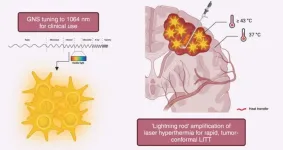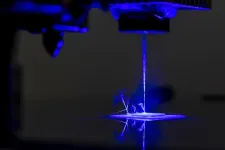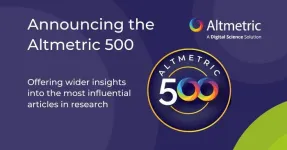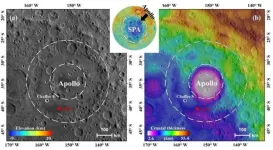(Press-News.org) LAWRENCE — Many people are familiar with oncogenes — genes long known to be involved in cancers in humans, such as the gene “Src.”
What’s less widely understood is that oncogenes didn’t evolve just to cause cancer in species, but rather to control events of normal growth and differentiation.
“As an organism grows from a single fertilized egg to form all the different tissue types, these oncogenes, including Src, evolved to control these normal events,” said Erik Lundquist, professor of molecular biosciences and associate vice chancellor for research at the University of Kansas. “To understand what these oncogenes are doing in cancer, it's important to understand what they're doing in normal development when they're not defective. When Src gets a mutation that causes it to be defective, it becomes an oncogene. But we're looking at what Src does in a normal developmental context.”
Now, in new research appearing in PLOS ONE, Lundquist and colleagues from his lab at KU have added new specifics to the role Src plays in our biology, showing the gene is required for healthy development of the nervous system.
The work depended on a model organism called C. elegans, a nematode worm whose Src gene is very similar to humans — but called “SRC-1.”
“The fun thing is that by the time humans and this worm last had a common ancestor, about 600 million years ago, most of the functions of the Src protein had already been worked out in that common ancestor,” Lundquist said. “What we study about the SRC-1 protein in this model organism, the nematode worm, will be relevant to what it's doing in human growth and development and therefore human pathogenesis and cancer.”
By using CRISPR gene editing technology in Lundquist’s lab to knock out the SRC-1 gene’s function entirely in the nematodes, the KU researchers showed the gene plays a key role in development of the nervous system by guiding axons.
“As the nervous system develops, neurons are born, and they have to elaborate these structures called axons,” Lundquist said. “Axons are the electrical wiring of the nervous system. The SRC-1 protein is involved in the normal development of these axons.
“For example, in a human context, if you have a motor neuron born in your spinal cord, how does the axon get out to your fingertip to a muscle versus to your stomach to a muscle? That's called axon guidance. The SCR-1 protein is a key player in axon guidance, and this paper shows that.”
Lundquist’s collaborators at KU were graduate research assistant Snehal Mahadik and former undergraduate student Emily Burt.
“Snehal was a graduate student in our lab initially, did the work and received her Ph.D. a couple of years ago,” Lundquist said. “She also worked with an undergraduate student in the lab who's also an author on the paper — Emily, who helped do a lot of the experiments and was responsible for some of the analysis. Snehal did the genome editing, but Emily did many of the surrounding experiments.”
The KU team established new details about how SRC-1 is involved in the growth of axons, finding SRC-1 regulates a cellular structure called a growth cone.
“It’s like the steering wheel of the axon that guides the axon to its target — either a motor neuron or another neuron in the nervous system — to form a synapse,” Lundquist said. “Because the axon needs to be in place for a synapse to form, the SRC-1 protein acts in axon guidance.”
Moreover, the team settled scientific debate about how SRC-1 contributes to axon guidance in normal development.
“There had been some discrepancies in the literature about the role of this gene, and we settled that by deleting it entirely — which is quite definitive,” Lundquist said. “It turns out the mutation most people were using to study SRC-1 in worms wasn’t a loss of gene function. It was an activated form of the gene, more like what an oncogene does.”
Lundquist, who also serves with the KU Cancer Center and KU Center for Genomics, said oncogenes often lose their ability to be regulated by other proteins, leading to uncontrolled activity that can cause carcinogenesis.
“The mutation in the SRC-1 gene was like this,” he said. “But we did a clean, precise knockout, ensuring the gene had no potential function in the organism. We found the phenotype (its physical appearance) was opposite of the previous mutation, confirming the previous mutation was not a loss of function but an overactive form of the gene.”
The work is the initial step in developing new therapies for spinal cord injuries and stroke, which involve neuron damage and death.
“In genetics, there are often cassettes of molecules that are reused in different events,” Lundquist said. “We're looking at and defining a cassette that's being used by Src in axon guidance. But that same cassette might also be involved in processes related to oncogenesis and cancer. This understanding gives us more targets for therapeutic intervention.”
The KU researcher said if scientists can understand how Src is engaging its effectors, it broadens the target for therapeutic intervention with proteins that can be specifically modified by particular pharmaceutical compounds, maybe in ways that weren't previously appreciated. For this reason, the research was supported by the National Institutes of Health.
“That's the bigger picture importance to biomedical research — understanding how these proteins relate to each other in this context,” he said. “There's also the potential for repairing or alleviating the effects of stroke, hypoxia and nerve damage after stroke or spinal cord injury. Our central nervous systems do not regenerate well, so understanding how neurons normally grow might eventually help us understand how they might regrow.”
END
Study reveals same genes that can drive cancer also guide neural-circuit growth
2024-06-24
ELSE PRESS RELEASES FROM THIS DATE:
Leveraging gold nanostars for precision laser interstitial thermal therapy
2024-06-24
“Gold nanostars amplify brain-tumor selective laser interstitial thermal therapy.”
BUFFALO, NY- June 24, 2024 – A new editorial paper was published in Oncotarget's Volume 15 on June 14, 2024, entitled, “Leveraging gold nanostars for precision laser interstitial thermal therapy.”
In this new editorial, researchers Aden P. Haskell-Mendoza, Ethan S. Srinivasan, Tuan Vo-Dinh and Peter E. Fecci from Duke University discuss laser interstitial thermal therapy (LITT). Over the past decade, LITT has become an important tool for the neurosurgical treatment of a variety of intracranial pathologies, including focal epilepsies, vascular malformations, and ...
Biodiversity loss from 2010 oil spill worse than predicted
2024-06-24
A new peer-reviewed study from researchers at The University of Texas at Arlington; the University of Nevada, Reno; Mokwon University in Daejeon, Korea; and Texas A&M University at Corpus Christi shows the Deepwater Horizon (DWH) oil spill of 2010 affected wildlife and their habitat much more than previously understood.
“Overall, we found the area of deep-sea floor affected by the DWH spill was significantly larger than previously thought,” said Masoud Rostami, an author of the study and assistant ...
New model shows more realistic picture of intimate partner violence
2024-06-24
ITHACA, N.Y. – Intimate partner violence is notoriously underreported and correctly diagnosed at hospitals only around a quarter of the time, but a new method provides a more realistic picture of who is most affected, even when cases go unrecorded.
PURPLE (Positive Unlabeled Relative PrevaLence Estimator), an algorithm developed by researchers at Cornell University, estimates how often underreported health conditions occur in different demographic groups. Using hospital data, the researchers showed that PURPLE can better quantify which groups of women are most likely to experience intimate partner violence compared with methods that ...
Damon Runyon announces inaugural class of SPARK Scholars
2024-06-24
The Damon Runyon Cancer Research Foundation has named the first cohort of the Damon Runyon Scholars Program for Advancing Research and Knowledge (SPARK), a one-year intensive cancer research internship program for post-baccalaureate students who come from varied backgrounds . The goal of the program is to provide young trainees who have the potential to become leaders in cancer research with rigorous scientific training and a network of mentors and peers to support their next steps into graduate school and beyond.
SPARK Scholars will conduct ...
No assembly required
2024-06-24
University of Missouri researchers have developed a way to create complex devices with multiple materials — including plastics, metals and semiconductors – all with a single machine.
The research, which was recently published in Nature Communications, outlines a novel 3D printing and laser process to manufacture multi-material, multi-layered sensors, circuit boards and even textiles with electronic components.
It’s called the Freeform Multi-material Assembly Process, and it promises to revolutionize ...
Circulating microRNAs likely as effective as A1C for predicting type 2 diabetes in youth, according to OU study
2024-06-24
Type 2 diabetes in young people ages 10 to19 has more than doubled in the past 20 years, yet it remains difficult for physicians to predict who will be diagnosed and who will improve with treatment. A newly published study from the University of Oklahoma shows that measuring the circulating abundance of microRNAs – which affect insulin-producing beta cells in the pancreas – is likely as effective as measuring the level of sugar in the blood for determining how a young person with the condition will fare.
Jeanie Tryggestad, M.D., an associate professor of pediatrics in the OU College of Medicine, led the study, which is published in The Journal of Clinical ...
UMass Amherst scientists to help launch the future of RNA research and biomedicine
2024-06-24
AMHERST, Mass. – Craig Martin, professor of chemistry, and Sarah Perry, associate professor of chemical engineering, both at the University of Massachusetts Amherst, recently received support from the National Institutes of Health (NIH) to develop a novel approach toward efficiently, reliably and cost effectively synthesizing novel strands of specialty “long RNA.” Future genetic research into everything from basic cell biology to advanced therapeutics depends in part on having just the sort of complex, modified RNA that Martin and Perry will be working to make widely available.
RNA is a molecule ...
Myths about intermittent fasting, debunked
2024-06-24
In a new article, researchers at the University of Illinois Chicago debunk four common myths about the safety of intermittent fasting.
Intermittent fasting has become an increasingly popular way to lose weight without counting calories. And a large body of research has shown it’s safe. Still, several myths about fasting have gained traction among clinicians, journalists and the general public: that fasting can lead to a poor diet or loss of lean muscle mass, cause eating disorders, or decrease sex hormones.
In a new commentary in Nature Reviews Endocrinology, UIC researchers debunk each of these. They base their ...
Altmetric 500 data offers wider insight into research’s most influential articles
2024-06-24
Digital Science, a technology company serving stakeholders across the research ecosystem, today announces an exciting new tranche of data that throws light on how and why research cuts through to society at large – in the shape of the Altmetric 500.
A decade on from the first Altmetric 100 reports, which listed the most influential academic articles in a given year, a leading provider of alternative metrics for published research is now releasing an upgraded overview of research engagement: the Altmetric ...
Geologists expect Chang’e-6 lunar surface samples to contain volcanic rock and impact ejecta
2024-06-24
On June 25, China’s Chang’e-6 (CE-6) lunar probe is set to return to Earth, carrying the first surface samples collected from the farside of the Moon. In anticipation of this historic event, scientists from the Institute of Geology and Geophysics at the Chinese Academy of Sciences are publishing their predictions for the unique materials that may be found in the CE-6 samples in the journal The Innovation.
Based on the geological characteristics of the probe’s landing site, the researchers anticipate that the returned surface samples will consist of 2.5-million-year-old volcanic rock combined with ...






